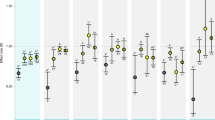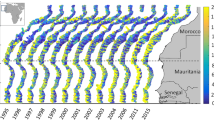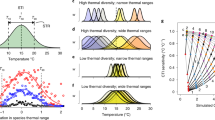Abstract
Minimizing the impact of ocean acidification requires an understanding of species responses and environmental variability of population habitats. Whereas the literature is growing rapidly, emerging results suggest unresolved species- or population-specific responses. Here we present a meta-analysis synthesizing experimental studies examining the effects of pCO2 on biological traits in marine invertebrates. At the sampling locations of experimental animals, we determined environmental pCO2 conditions by integrating data from global databases and pCO2 measurements from buoys. Experimental pCO2 scenarios were compared with upper pCO2 using an index considering the upper environmental pCO2. For most taxa, a statistically significant negative linear relationship was observed between this index and mean biological responses, indicating that the impact of a given experimental pCO2 scenario depends on the deviation from the upper pCO2 level experienced by local populations. Our results highlight the importance of local biological adaptation and the need to consider present pCO2 natural variability while interpreting experimental results.
This is a preview of subscription content, access via your institution
Access options
Access Nature and 54 other Nature Portfolio journals
Get Nature+, our best-value online-access subscription
$29.99 / 30 days
cancel any time
Subscribe to this journal
Receive 12 print issues and online access
$209.00 per year
only $17.42 per issue
Buy this article
- Purchase on Springer Link
- Instant access to full article PDF
Prices may be subject to local taxes which are calculated during checkout



Similar content being viewed by others
References
Gattuso, J.-P. et al. Contrasting futures for ocean and society from different anthropogenic CO2 emissions scenarios. Science 349, aac4722 (2015).
Caldeira, K. & Wickett, M. E. Anthropogenic carbon and ocean pH. Nature 425, 365 (2003).
Hönisch, B. et al. The geological record of ocean acidification. Science 335, 1058–1063 (2012).
Turley, C. & Gattuso, J.-P. Future biological and ecosystem impacts of ocean acidification and their socioeconomic-policy implications. Curr. Opin. Environ. Sustain. 4, 278–286 (2012).
San Martin, V. A. et al. Linking social preferences and ocean acidification impacts in mussel aquaculture. Sci. Rep. 9, 4719 (2019).
Falkenberg, L. et al. Ocean acidification and human health. Int. J. Environ. Res. Public Health 17, 4563 (2020).
Loewe, M. & Rippin, N. The Sustainable Development Goals of the Post-2015 Agenda. Comments on the OWG and SDSN Proposals (German Development Institute 2015).
Doney, S. C. et al. The impacts of ocean acidification on marine ecosystems and reliant human communities. Annu. Rev. Environ. Resour. 45, 83–112 (2020).
Ekstrom, J. et al. Vulnerability and adaptation of US shellfisheries to ocean acidification. Nat. Clim. Change 5, 207–214 (2015).
Ponce Oliva, R. D. et al. Ocean acidification, consumers’ preferences, and market adaptation strategies in the mussel aquaculture industry. Ecol. Econ. 158, 42–50 (2019).
Quatrinni, A. M. et al. Palaeoclimate ocean conditions shaped the evolution of corals and their skeletons through deep time. Nat. Ecol. Evol. 4, 1531–1538 (2020).
Thomsen, J. et al. Naturally acidified habitat selects for ocean acidification-tolerant mussels. Sci. Adv. 3, e1602411 (2017).
Rastrick, S. S. P. et al. Using natural analogues to investigate the effects of climate change and ocean acidification on Northern ecosystems. ICES J. Mar. Sci. 75, 2299–2311 (2018).
Hall-Spencer, J. M. et al. Volcanic carbon dioxide vents reveal ecosystem effects of ocean acidification. Nature 454, 96–99 (2008).
Agostini, S. et al. Ocean acidification drives community shifts towards simplified non-calcified habitats in a subtropical–temperate transition zone. Sci. Rep. 8, 11354 (2018).
Riquelme-Bugueño, R. et al. Diel vertical migration into anoxic and high-pCO2 waters: acoustic and net-based krill observations in the Humboldt Current. Sci. Rep. 10, 17181 (2020).
Pérez et al. Riverine discharges impact physiological traits and carbon sources for shell carbonate in the marine intertidal mussel Perumytilus purpuratus. Limnol. Oceanogr. 61, 969–983 (2016).
Vargas, C. A. et al. Species-specific responses to ocean acidification should account for local adaptation and adaptive plasticity. Nat. Ecol. Evol. 1, 0084 (2017).
Saavedra et al. Local habitat influences on feeding and respiration of the intertidal mussels Perumytilus purpuratus exposed to increased pCO2 levels. Estuaries Coast. 41, 1118–1129 (2018).
Riebesell, U. & Gattuso, J.-P. Lessons learned from ocean acidification research. Nat. Clim. Change 5, 12–14 (2015).
Tilbrook, B. et al. An enhanced ocean acidification observing network: from people to technology to data synthesis and information exchange. Front. Mar. Sci. 6, 337 (2019).
Barry, J. P., Hall-Spencer, J. M. and Tyrrell, T. in Guide to Best Practices for Ocean Acidification Research and Data Reporting (eds Riebesell, U. et al.) Ch. 3 (Publications Office of the European Union, 2010).
Vargas, C. A. et al. Influence of glacier melting and river discharges on the nutrient distribution and DIC recycling in the southern Chilean Patagonia. J. Geophys. Res. Biogeosci. 123, 256–270 (2018).
Feely, R. A. et al. Evidence for upwelling of corrosive ‘acidified’ water onto the Continental Shelf. Science 320, 1490–1492 (2008).
Vargas, C. A. et al. Riverine and corrosive upwelling waters influences on the carbonate system in the coastal upwelling area off Central Chile: implications for coastal acidification events. J. Geophys. Res. Biogeosci. 121, 1468–1483 (2016).
Cao, Z. et al. Dynamics of the carbonate system in a large continental shelf system under the influence of both a river plume and coastal upwelling. J. Geophys. Res. Oceans 116, G02010 (2010).
Feely, R. A. et al. The combined effects of ocean acidification, mixing, and respiration on pH and carbonate saturation in an urbanized estuary. Est. Coast. Shelf Sci. 88, 442–449 (2010).
Cai, W.-J. et al. Acidification of subsurface coastal waters enhanced by eutrophication. Nat. Geosci. 4, 766–770 (2011).
Kwiatkowski, L. et al. Nighttime dissolution in a temperate coastal ocean ecosystem increases under acidification. Sci. Rep. 6, 22984 (2016).
Wolfe, K., Nguyen, H. D., Davey, M. & Byrne, M. Characterizing biogeochemical fluctuations in a world of extremes: a synthesis for temperate intertidal habitats in the face of global change. Glob. Change Biol. 26, 3858–3879 (2020).
Shaw, E. C., Phinn, S. R., Tilbrook, B. & Steven, A. Natural in situ relationships suggest coral reef calcium carbonate production will decline with ocean acidification. Limnol. Oceanogr. 60, 777–788 (2015).
Takeshita, Y. et al. Coral reef carbonate chemistry variability at different functional scales. Front. Mar. Sci. 5, 175 (2018).
Brodeur, J. R. et al. Chesapeake Bay inorganic carbon: spatial distribution and seasonal variability. Front. Mar. Sci. 6, 99 (2019).
Hoshijima, U. & Hofmann, G. E. Variability of seawater chemistry in a kelp forest environment is linked to in situ transgenerational effects in the purple sea urchin, Strongylocentrotus purpuratus. Front. Mar. Sci. 6, 62 (2019).
Koweek, D. A. et al. A year in the life of a central California kelp forest: physical and biological insights into biogeochemical variability. Biogeosciences 14, 31–44 (2017).
Cornwall, C. E. & Hurd, C. L. Experimental design in ocean acidification research: problems and solutions. ICES J. Mar. Sci. 73, 572–581 (2016).
Kapsenberg, L. & Hofmann, G. E. Ocean pH time-series and drivers of variability along the northern Channel Islands, California, USA. Limnol. Oceanogr. 61, 953–968 (2016).
Hofmann, G. E. et al. High-frequency dynamics of ocean pH: a multi-ecosystem comparison. PLoS ONE 6, e28983 (2011).
Baumann, H. Experimental assessments of marine species sensitivities to ocean acidification and co-stressors: how far have we come? Can. J. Zool. 97, 399–408 (2019).
Cornwall, C. E. et al. Diurnal fluctuations in seawater pH influence the response of a calcifying macroalga to ocean acidification. Proc. R. Soc. B 280, 20132201 (2013).
Rivest, E. B., Comeau, S. & Cornwall, C. E. The role of natural variability in shaping the response of coral reef organisms to climate change. Curr. Clim. 3, 271–281 (2017).
Sanford, E. & Kelly, M. W. Local adaptation in marine invertebrates. Annu. Rev. Mar. Sci. 3, 509–535 (2011).
Lewis, C. N. et al. Sensitivity to ocean acidification parallels natural pCO2 gradients experienced by Arctic copepods under winter sea ice. Proc. Natl Acad. Sci. USA 110, E4960–E4967 (2013).
Spalding, M. D. et al. Marine ecoregions of the world: a bioregionalization of coastal and shelf areas. BioScience 57, 573–583 (2007).
Aguilera, V. M., Vargas, C. A. & Dewitte, B. Intraseasonal hydrographic variations and nearshore carbonates system off northern Chile during the 2015 El Niño event. J. Geophys. Res. Biogeosci. 125, e2020JG005704 (2020).
Fassbender, A. J. et al. Seasonal carbonate chemistry variability in marine surface waters of the US Pacific Northwest. Earth Syst. Sci. Data 10, 1367–1401 (2018).
Reum, J. C. P. et al. Seasonal carbonate chemistry covariation with temperature, oxygen, and salinity in a fjord estuary: implications for the design of ocean acidification experiments. PLoS ONE 9, e89619 (2014).
Wallace, R. B. et al. Coastal ocean acidification: the other eutrophication problem. Estuar. Coast. Shelf Sci. 148, 1–13 (2014).
Rutgersson, A. et al. The annual cycle of carbon dioxide and parameters influencing the air–sea carbon exchange in the Baltic Proper. J. Mar. Syst. 74, 381–394 (2008).
Clargo, N. M., Salt, L. A., Thomas, H. & de Baar, H. J. W. Rapid increase of observed DIC and pCO2 in the surface waters of the North Sea in the 2001–2011 decade ascribed to climate change superimposed by biological processes. Mar. Chem. 177, 566–581 (2015).
Ericson, Y. et al. Temporal variability in surface water pCO2 in Adventfjorden (West Spitsbergen) with emphasis on physical and biogeochemical drivers. J. Geophys. Res. Oceans 123, 4888–4905 (2018).
Geilfus, N.-X. et al. Spatial and temporal variability of seawater pCO2 within the Canadian Arctic Archipelago and Baffin Bay during the summer and autumn 2011. Cont. Shelf Res. 156, 1–10 (2018).
Islam, F. et al. Sea surface pCO2 and O2 dynamics in the partially ice-covered Arctic Ocean. J. Geophys. Res. Oceans 122, 1425–1438 (2016).
Copin-Montégut, C., Bégovic, M. & Merlivat, L. Variability of the partial pressure of CO2 on diel to annual time scales in the Northwestern Mediterranean Sea. Mar. Chem. 85, 169–189 (2004).
Pardo, P. C. et al. Surface ocean carbon dioxide variability in South Pacific boundary currents and Subantarctic waters. Sci. Rep. 9, 7592 (2019).
Gagliano, M., McCormick, M. I., Moore, J. A. & Depczynski, M. The basics of acidification: baseline variability of pH on Australian coral reefs. Mar. Biol. 157, 1849–1856 (2010).
Takeshita, Y. et al. Including high-frequency variability in coastal acidification projections. Biogeosciences 12, 5853–5870 (2015).
Carter, H. A., Ceballos-Osuna, L., Miller, N. A. & Stillman, J. H. Impact of ocean acidification on metabolism and energetics during early life stages of the intertidal porcelain crab Petrolisthes cinctipes. J. Exp. Biol. 216, 1412–1422 (2013).
Ceballos-Osuna, L., Carter, H. A., Miller, N. A. & Stillman, J. H. Effects of ocean acidification on early life-history stages of the intertidal porcelain crab Petrolisthes cinctipes. J. Exp. Biol. 216, 1405–1411 (2013).
Miller, S. H. et al. Effect of elevated pCO2 on metabolic responses of porcelain crab (Petrolisthes cinctipes) larvae exposed to subsequent salinity stress. PLoS ONE 9, e109167 (2014).
Bayne, B. L. Metabolic expenditure. Dev. Aquacult. Fish. Sci. 41, 331–415 (2017).
Waldbusser, G. G. et al. Slow shell building, a possible trait for resistance to the effects of acute ocean acidification. Limnol. Oceanogr. 61, 1969–1983 (2016).
Dorey, N., Lancon, P., Thorndyke, M. & Dupont, S. Assessing physiological tipping point for sea urchin larvae exposed to a broad range of pH. Glob. Change Biol. 19, 3355–3367 (2013).
Kelly, M. W., Padilla-Gamiño, J. L. & Hofmann, G. E. Natural variation and the capacity to adapt to ocean acidification in the keystone sea urchin Strongylocentrotus purpuratus. Glob. Change Biol. 19, 2536–2546 (2015).
Gaitán-Espitia, J. D. et al. Spatio–temporal environmental variation mediates geographical differences in phenotypic responses to ocean acidification. Biol. Lett. 13, 20160865 (2017).
Calosi, P. et al. Distribution of sea urchins living near shallow water CO2 vents is dependent upon species acid–base and ion-regulatory abilities. Mar. Pollut. Bull. 73, 470–484 (2013).
Foo, S. A., Dworjanyn, S. A., Poore, A. G. B. & Byrne, M. Adaptive capacity of the habitat modifying sea urchin Centrostephanus rodgersii to ocean warming and ocean acidification: performance of early embryos. PLoS ONE 7, e42497 (2012).
Chan, K. Y. K., Grünbaum, D., Arnberg, M. & Dupont, S. Impacts of ocean acidification on survival, growth, and swimming behaviours differ between larval urchins and brittlestars. ICES J. Mar. Sci. 73, 951–996 (2016).
Stumpp, M. et al. Acidified seawater impacts sea urchin larvae pH regulatory systems relevant for calcification. Proc. Natl Acad. Sci. USA 109, 18192–18197 (2012).
Stumpp, M. et al. Digestion in sea urchin larvae impaired under ocean acidification. Nat. Clim. Change 3, 1044–1049 (2013).
Thor, P. & Dupont, S. Transgenerational effects alleviate severe fecundity loss during ocean acidification in a ubiquitous planktonic copepod. Glob. Change Biol. 21, 2261–2271 (2015).
Gibbin, E. M. et al. The evolution of phenotypic plasticity under global change. Sci. Rep. 7, 17253 (2017).
Gibbin, E. M. et al. Can multi-generational exposure to ocean warming and acidification lead to the adaptation of life history and physiology in a marine metazoan? J. Exp. Biol. 220, 551–563 (2017).
Dam, H. G. et al. Rapid, but limited, zooplankton adaptation to simultaneous warming and acidification. Nat. Clim. Change 11, 780–786 (2021).
Byrne, M. Impact of ocean warming and ocean acidification on marine invertebrate life history stages: vulnerabilities and potential for persistence in a changing ocean. Oceanogr. Mar. Biol. 49, 1–42 (2011).
Kroeker, K. J., Kordas, R. L., Crim, R. N. & Singh, G. G. Meta-analysis reveals negative yet variable effects of ocean acidification on marine organisms. Ecol. Lett. 13, 1419–1434 (2010).
Kroeker et al. Impacts of ocean acidification on marine organisms: quantifying sensitivities and interaction with warming. Glob. Change Biol. 19, 1884–1896 (2013).
Takahashi, T., Sutherland, S. C. & Kozyr, A. LDEO Database (Version 2019): Global Ocean Surface Water Partial Pressure of CO2 Database: Measurements Performed During 1957–2019 (NCEI Accession 0160492) Version 9.9 (National Oceanic and Atmospheric Administration National Centers for Environmental Information); https://doi.org/10.3334/CDIAC/OTG.NDP088(V2015)
Manly, B. F. J. Randomization, Bootstrap and Monte Carlo Methods in Biology (CRC Press, 1997).
Martinez, W. L. & Martinez, A. R. Computational Statistics Handbook with MATLAB (CRC Press, 2002).
Acknowledgements
This work was supported by FONDECYT project number 1210171 to C.A.V. and 1181300 to B.R.B. Additional support from the Agencia Nacional de Investigación y Desarrollo (ANID)–Millennium Science Initiative Program–Millennium Institute of Oceanography (IMO) ICN12_019, the Coastal Socio-Ecological Millennium Institute (SECOS) ICN2019_015 and the Millennium Science Initiative Nucleus–Understanding Past coastal upWelling systems and Environmental Local and Lasting impacts (UPWELL) NCN19-153 is also acknowledged. S.D. is funded by the Swedish Research Councils Formas. We greatly thank F. Gamonal from IMO for the design of Fig. 1.
Author information
Authors and Affiliations
Contributions
All authors provided input into data availability and preliminary discussions. C.A.V., B.R.B. and L.A.C. carried out data analysis, and C.A.V. designed the main structure of the study. C.A.V. led the drafting of the text with contributions from S.D., B.R.B., L.A.C., J.D.G.-E., N.A.L. and V.A.S.M.
Corresponding author
Ethics declarations
Competing interests
The authors declare no competing interests.
Peer review
Peer review information
Nature Climate Change thanks Hannes Baumann and the other, anonymous, reviewer(s) for their contribution to the peer review of this work.
Additional information
Publisher’s note Springer Nature remains neutral with regard to jurisdictional claims in published maps and institutional affiliations.
Supplementary information
Supplementary Information
Supplementary Figs. 1–5 and Table 1.
41558_2021_1269_MOESM3_ESM.xlsx
Supplementary Dataset 1: pCO2 values extracted from the LDEO database version 2019 used in this study and separated by coastal regions. Date of sampling and coordinates of each position have been included.
41558_2021_1269_MOESM4_ESM.xlsx
Supplementary Dataset 2: List of all taxa, life stage CO2 values used for the different biological traits considered in our study.
Rights and permissions
About this article
Cite this article
Vargas, C.A., Cuevas, L.A., Broitman, B.R. et al. Upper environmental pCO2 drives sensitivity to ocean acidification in marine invertebrates. Nat. Clim. Chang. 12, 200–207 (2022). https://doi.org/10.1038/s41558-021-01269-2
Received:
Accepted:
Published:
Issue Date:
DOI: https://doi.org/10.1038/s41558-021-01269-2
This article is cited by
-
Hidden impacts of ocean warming and acidification on biological responses of marine animals revealed through meta-analysis
Nature Communications (2024)
-
Oxygen dynamics in marine productive ecosystems at ecologically relevant scales
Nature Geoscience (2023)
-
Environmental stability and phenotypic plasticity benefit the cold-water coral Desmophyllum dianthus in an acidified fjord
Communications Biology (2022)



